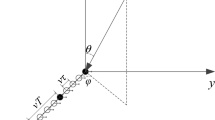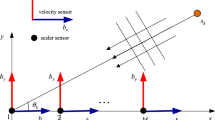Abstract
This paper investigates the estimation of the two-dimensional direction of arrival (2D-DOA) of sound sources using an acoustic vector sensor array (AVSA) within a spatial sparse representation (SSR) framework (AVS-SSR-DOA). SSR-DOA estimation methods rely on a pre-defined grid of possible source DOAs and essentially suffer from the grid-effect problem: Reducing the size of the grid spacing leads to increased computational complexity. In this paper, we propose a two-step approach to tackle the grid-effect problem. Specifically, omnidirectional sensor array-based SSR-DOA estimation firstly provides initial low-cost DOA estimates using a coarse grid spacing. Secondly, a closed-form solution is derived by exploring the unique subarray manifold matrix correlation and subarray signal correlation of the AVSA, which allows for DOA estimates between the pre-defined angles of the grid and potentially achieves higher DOA estimation accuracy. To further alleviate the estimation bias due to noise and sparse representation model errors, line-fitting (LF) techniques and subspace techniques (ST) are employed to develop two novel DOA estimation algorithms, referred to as AVS-SSR-LF and AVS-SSR-ST, respectively. Extensive simulations validate the effectiveness of the proposed algorithms when estimating the DOAs of multiple sound sources. The proposed AVS-SSR-ST algorithm achieves high DOA estimation accuracy and is robust to various noise levels and source separation angles.






Similar content being viewed by others
References
H. Chen, J. Zhao, Coherent signal-subspace processing of acoustic vector sensor array for DOA estimation of wideband sources. Signal Process. 85(4), 837–847 (2005)
I. Gorodnitsky, B. Rao, Sparse signal reconstruction from limited data using FOCUSS: a re-weighted minimum norm algorithm. IEEE Trans. Signal Process. 45(3), 600–616 (1997)
M. Grant, S. Boyd, CVX: matlab software for disciplined convex programming. http://cvxr.com/cvx/ (2011)
M. Hawkes, A. Nehorai, Acoustic vector-sensor beamforming and Capon direction estimation. IIEEE Trans. Signal Process. 46(9), 2291–2304 (1998)
M.M. Hyder, K. Mahata, Direction-of-arrival estimation using a mixed \(l_{2,0}\) norm approximation. IEEE Trans. Signal Process. 58(9), 4646–4655 (2010)
H. Krim, M. Viberg, Two decades of array signal processing research: the parametric approach. IEEE Signal Process. Mag. 13(4), 67–94 (1996)
B. Li, Y.X. Zou, Y.S. Zhu, Direction estimation under compressive sensing framework: a review and experimental results, in Proceedings of IEEE International Conference on Information and Automation ( ICIA) (2011), pp. 63-68
B. Li, Y.X. Zou, Improved DOA estimation with acoustic vector sensor arrays using spatial sparsity and subarray manifold, in Proceedings of the ICASSP (2012), pp. 2557–2560
Z. Liu, X. Ruan, J. He, Efficient 2-D DOA estimation for coherent sources with a sparse acoustic vector-sensor array. Multidimens. Syst. Sign. Process. 24(1), 105–120 (2013)
D.M. Malioutov, A sparse signal reconstruction perspective for source localization with sensor arrays. http://ssg.mit.edu/~dmm/publications/malioutov_MS_thesis.pdf (2003)
D.M. Malioutov, M. Cetin, A. Willsky, A sparse signal reconstruction perspective for source localization with sensor arrays. IEEE Trans. Signal Proces. 53(8), 3010–3022 (2005)
A. Nehorai, E. Paldi, Acoustic vector-sensor array processing. IEEE Trans. Signal Process. 42(9), 2481–2491 (1994)
P. Palanisamy, N. Kalyanasundaram, P.M. Swetha, Two-dimensional DOA estimation of coherent signals using acoustic vector sensor array. Signal Process. 92(1), 19–28 (2012)
P. Tichavský, K.T. Wong, M.D. Zoltowski, Near-field/far-field azimuth and elevation angle estimation using a single vector hydrophone. IEEE Trans. Signal Process. 49(11), 2498–2510 (2001)
E.W. Weisstein, Least squares fitting. http://mathworld.wolfram.com/LeastSquaresFitting.html (2012)
K.T. Wong, M.D. Zoltowski, Closed-form underwater acoustic direction-finding with arbitrarily spaced vector hydrophones at unknown locations. IEEE J. Ocean. Eng. 22(3), 649–658 (1997)
K.T. Wong, M.D. Zoltowski, Extended-aperture underwater acoustic multisource azimuth/elevation direction-finding using uniformly but sparsely spaced vector hydrophones. IEEE J. Ocean. Eng. 22(4), 659–672 (1997)
K.T. Wong, M.D. Zoltowski, Root-MUSIC-based azimuth-elevation angle-of-arrival estimation with uniformly spaced but arbitrarily oriented velocity hydrophones. IEEE Trans. Signal Process. 47(12), 3250–3260 (1999)
K.T. Wong, M.D. Zoltowski, Self-initiating MUSIC-based direction finding in underwater acoustic particle velocity-field beamspace. IEEE J. Ocean. Eng. 25(2), 262–273 (2000)
Y.I. Wu, K.T. Wong, Acoustic near-field source-localization by two passive anchor-nodes. IEEE Trans. Aerosp. Electron. Syst. 48(1), 159–169 (2012)
Y. Xu, Z. Liu, J. Cao, Noncircularity-exploitation in direction estimation of noncircular signals with an acoustic vector-sensor. Digit. Signal Process. 18(5), 777–796 (2008)
X. Xu, X. Wei, Z. Ye, DOA estimation based on sparse signal recovery utilizing weighted \(l_{1}\)-norm penalty. IEEE Signal Process. Lett. 19(3), 155–158 (2012)
J. Yin, T. Chen, Direction-of-Arrival estimation using a sparse representation of array covariance vectors. IEEE Trans. Signal Process. 59(9), 4489–4493 (2011)
J. Zheng, M. Kaveh, H. Tsuji, Sparse spectral fitting for Direction of Arrival and power estimation, in IEEE/SP 15th Workshop on Statistical Signal Processing (2009), pp. 429–432
J. Zheng, M. Kaveh, Direction-of-arrival estimation using a sparse spatial spectrum model with uncertainty, in Proceedings of the ICASSP (2011), pp. 2848–2851
C. Zheng, G. Li, H. Zhang, X. Wang, An approach of DOA estimation using noise subspace weighted \(l_{1}\) minimization, in Proceedings of the ICASSP (2011), pp. 2856–2859
X. Zhong, A.B. Premkumar, A.S. Madhukumar, Particle filtering and posterior Cramér-Rao bound for 2-D direction of arrival tracking using an acoustic vector sensor. IEEE Sens. J. 12(2), 363–377 (2012)
X. Zhong, A.B. Premkumar, Particle filtering approaches for multiple acoustic source detection and 2-D direction of arrival estimation using a single acoustic vector sensor. IEEE Trans. Signal Proces. 60(9), 4719–4733 (2012)
H. Zhu, G. Leus, G.B. Giannakis, Sparsity-cognizant total least-squares for perturbed compressive sampling. IEEE Trans. Signal Process. 59(5), 2002–2016 (2011)
Acknowledgments
This work is supported by National Natural Science Foundation of China (No: 61271309) and the Shenzhen Science and Technology Fundamental Research Program (No: JCY201110006).
Author information
Authors and Affiliations
Corresponding author
Rights and permissions
About this article
Cite this article
Zou, YX., Li, B. & Ritz, C.H. Multi-Source DOA Estimation Using an Acoustic Vector Sensor Array Under a Spatial Sparse Representation Framework. Circuits Syst Signal Process 35, 993–1020 (2016). https://doi.org/10.1007/s00034-015-0102-9
Received:
Revised:
Accepted:
Published:
Issue Date:
DOI: https://doi.org/10.1007/s00034-015-0102-9




